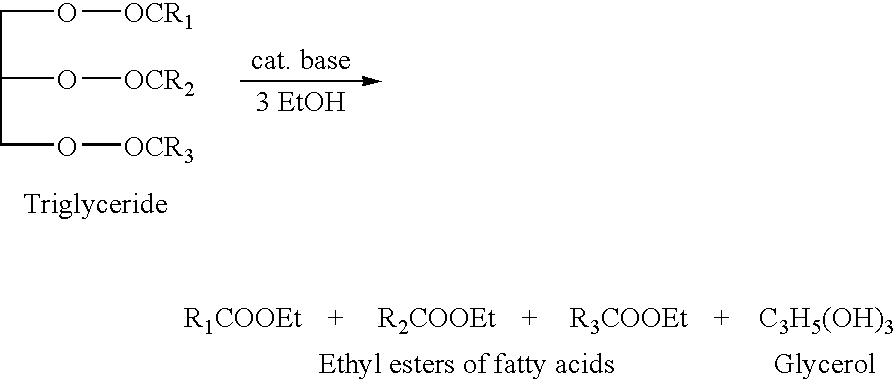Hydroprocessing Microalgal Oils
a technology of microorganisms and hydroprocessing, which is applied in the direction of fuels, organic chemistry, chemistry apparatus and processes, etc., can solve the problems of increasing the cost of fossil fuels, contributing significantly to the cost of traditional biodiesel production, and hazardous operating conditions affecting both environmental and worker safety aspects, so as to increase efficiency and reduce the cost of obtaining valuable materials
- Summary
- Abstract
- Description
- Claims
- Application Information
AI Technical Summary
Benefits of technology
Problems solved by technology
Method used
Image
Examples
example 1
Methods for Culturing Prototheca
[0327]Unless otherwise noted, all strains described in this and the following Examples were obtained from the University of Texas Culture Collection of Algae (Austin, Tex.). In this Example, Prototheca strains were cultivated to achieve a high percentage of oil by dry cell weight. Cryopreserved cells were thawed at room temperature and 500 ul of cells were added to 4.5 ml of medium (4.2 g / L K2HPO4, 3.1 g / L NaH2PO4, 0.24 g / L MgSO4.7H2O, 0.25 g / L Citric Acid monohydrate, 0.025 g / L CaCl2 2H2O, 2 g / L yeast extract) plus 2% glucose and grown for 7 days at 28° C. with agitation (200 rpm) in a 6-well plate. Dry cell weights were determined by centrifuging 1 ml of culture at 14,000 rpm for 5 min in a pre-weighed Eppendorf tube. The culture supernatant was discarded and the resulting cell pellet washed with 1 ml of deionized water. The culture was again centrifuged, the supernatant discarded, and the cell pellets placed at −80° C. until frozen. Samples were t...
example 2
Analysis of Extracted Oil and Delipidated Biomass
[0331]A. Extraction of Oil from Microalgae Using an Expeller Press and a Press Aid
[0332]Microalgal biomass containing 38% oil by DCW was dried using a drum dryer resulting in resulting moisture content of 5-5.5%. The biomass was fed into a French L250 press. 30.4 kg (67 lbs.) of biomass was fed through the press and no oil was recovered. The same dried microbial biomass combined with varying percentage of switchgrass as a press aid was fed through the press. The combination of dried microbial biomass and 20% w / w switchgrass yielded the best overall percentage oil recovery. The pressed cakes were then subjected to hexane extraction and the final yield for the 20% switchgrass condition was 61.6% of the total available oil (calculated by weight). Biomass with above 50% oil dry cell weight did not require the use of a pressing aid such as switchgrass in order to liberate oil.
[0333]Oil extracted from wildtype Prototheca moriformis UTEX 143...
example 3
Fuel Production
[0337]A. Production of Biodiesel from Prototheca Oil
[0338]Degummed oil from Prototheca moriformis UTEX 1435, produced according to the methods described above, was subjected to transesterification to produce fatty acid methyl esters. Results are shown below:
The lipid profile of the oil was:
C10:0 0.02
C12:0 0.06
C14:0 1.81
C14.1 0.07
C16:0 24.53
C16:1 1.22
C18:0 2.34
C18:1 59.21
C18:2 8.91
C18:3 0.28
C20:0 0.23
C20:1 0.10
C20:1 0.08
C21:0 0.02
C22:0 0.06
C24:0 0.10
[0339]
TABLE 6Biodiesel profile from Prototheca moriformis triglyceride oil.MethodTestResultUnitsASTMCold Soak Filterability ofFiltration Time120secD6751 A1Biodiesel Blend FuelsVolume Filtered300mlASTM D93Pensky-Martens Closed CupProcedure UsedAFlash PointCorrected Flash165.0° C.PointASTMWater and Sediment in MiddleSediment and Water0.000Vol %D2709Distillate Fuels (CentrifugeMethod)EN 14538Determination of Ca and MgSum of (Ca andmg / kgContent by ICP OESMg)EN 14538Determination of Ca and MgSum of (Na and K)mg / kgContent by ICP ...
PUM
 Login to View More
Login to View More Abstract
Description
Claims
Application Information
 Login to View More
Login to View More - R&D
- Intellectual Property
- Life Sciences
- Materials
- Tech Scout
- Unparalleled Data Quality
- Higher Quality Content
- 60% Fewer Hallucinations
Browse by: Latest US Patents, China's latest patents, Technical Efficacy Thesaurus, Application Domain, Technology Topic, Popular Technical Reports.
© 2025 PatSnap. All rights reserved.Legal|Privacy policy|Modern Slavery Act Transparency Statement|Sitemap|About US| Contact US: help@patsnap.com



